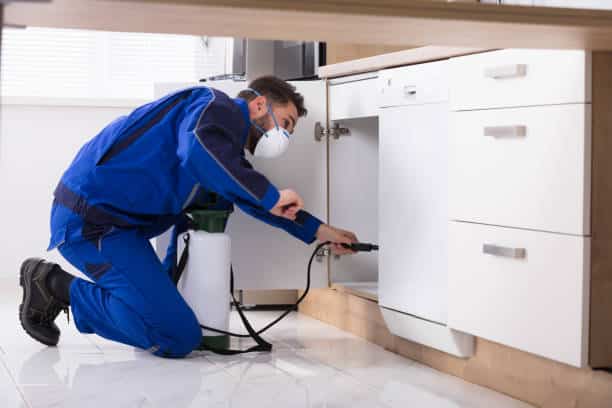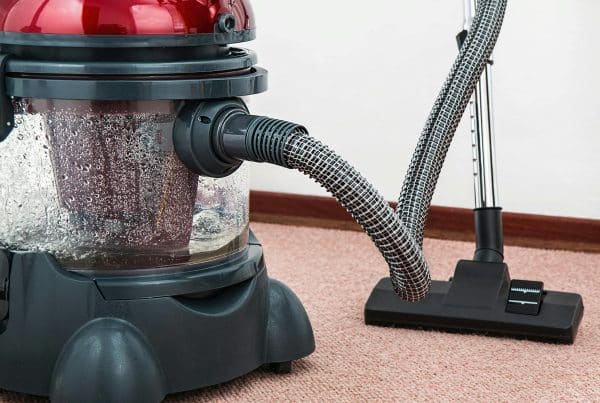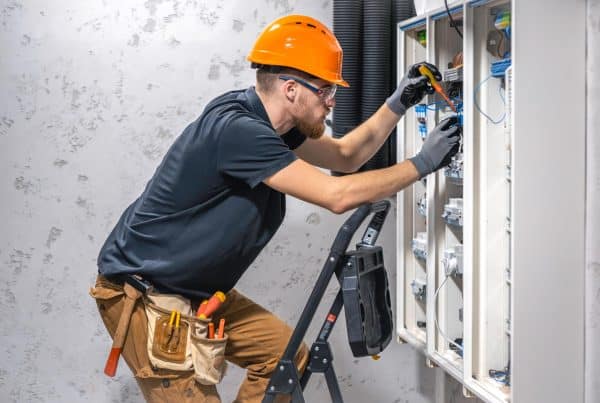The presence of pests and bugs in a home or business can pose an array of problems. Not only is it unhygienic to have these organisms living within one’s environment, but pest control issues can quickly become expensive if not addressed promptly. To help eliminate the dangers posed by pests and bugs, individuals should consider hiring a bug exterminator. This article will discuss the importance of utilizing a professional bug exterminator as well as the various services they provide.
Pests such as rodents, cockroaches, and other insects can wreak havoc on structures if left untreated for long periods of time. Many bugs also spread disease through their waste and saliva, which can prove hazardous to humans. Professional bug extermination utilizes methods that are designed to reduce infestations while remaining safe for human environments. These methods may include chemical treatments, traps, baits, heat treatments, and more, depending on the specific type of infestation being treated.
In order to ensure a successful elimination of pests from one’s property, it is important to hire an experienced bug exterminator who has knowledge of local laws concerning pesticide use along with current products available for treating different types of infestations. The benefit of working with an expert in this field is that they understand proper procedures when dealing with dangerous substances needed for eliminating unwanted creatures from homes and businesses alike.
Who Is A Bug Exterminator?
A bug exterminator is a professional who specializes in controlling or eliminating pests. They are trained to identify and remove various types of insects, such as ants, bedbugs, cockroaches, fleas, mites, ticks, spiders, and other arthropods, that can cause damage to property or spread disease. Bug exterminators use the most effective methods available to eliminate infestations without endangering human health or damaging the environment. This includes careful inspection of homes and businesses for signs of infestation; identification of the exact pest species; selection and application of appropriate pesticide treatments; removal of dead pests; and monitoring for future outbreaks.
In some cases, biological control measures may be used instead of chemical pesticides. These include introducing predators which feed on the target pests or using sterilized males to reduce reproduction rates. However, these techniques often require specialized knowledge and experience and may not always be successful in eradicating an infestation.
Understanding The Different Types Of Pests
In order to effectively exterminate bugs, it is important to understand the different types of pests that exist and how they can be dealt with. Pests come in various shapes and sizes, from microscopic insects like mites and fleas to larger animals such as raccoons and mice. Each type of pest requires a specific approach for extermination or control.
One broad category includes arthropods, which include ants, cockroaches, beetles, spiders, bedbugs, flies, and termites. These pests generally feed on organic matter found inside homes or businesses. Extermination methods vary depending on the species but may involve chemical treatments or traps. The use of natural predators such as birds or frogs can also help reduce populations when used in combination with other measures.
Rodents represent another class of pests commonly encountered by bug exterminators. Mice, rats, and squirrels typically enter structures looking for food sources and shelter from the elements. To eliminate these pests, it is essential to remove any possible attractants, such as pet food or garbage, while using humane trapping techniques where appropriate. Rat poisons are also available but should only be used under extreme circumstances due to their potential danger to humans and pets alike.
How To Identify Infestation Areas
Identifying the infestation areas of a home or other building is an important step in bug extermination. In order to properly eradicate any pest, it is essential that all affected areas are located and treated. Professionals often use high-powered flashlights and magnifying glasses to inspect walls, cracks, crevices, window sills, door frames, and baseboards for signs of insect activity. It can also be beneficial to look at furniture upholstery as well as carpeting for bugs such as fleas and bedbugs.
In some cases, it may be necessary to remove wall outlets or light switches in order to gain access to potential breeding grounds inside the walls. If this is not possible, professionals may rely on specialized listening devices which detect movement within the walls caused by insects or rodents. Additionally, various traps can be used to capture pests without having direct contact with them. Once all infested areas have been identified, the exterminator can then begin treatment using appropriate chemical agents designed to eliminate specific types of pests from the environment safely and effectively.
Insecticides And Other Chemical Solutions
Once an infestation area has been identified, the next step is to determine how to eradicate the pests. Insecticides and other chemical solutions are a common choice for pest control. Generally speaking, these chemicals work by disrupting the neurological or physiological processes of an insect’s body, resulting in death. Depending on the type of insect being targeted, certain classes of insecticide may be more effective than others. For example, contact pesticides can be used against crawling insects such as ants or cockroaches because they do not need to enter the host organism in order to take effect. On the other hand, systemic pesticides are better suited for killing flying insects like mosquitoes since they must penetrate into the system before taking effect.
In addition to traditional chemical solutions, there are also alternative methods available, including traps and baits, which rely on physical means rather than chemicals. Traps often use attractants such as pheromones or food-based lures, while baits use poison that gradually kills after ingestion. Both techniques can help reduce populations but require frequent maintenance and monitoring in order to remain effective over time.
Effective Non-Chemical Control Measures
Physical control measures can be used in the management of insect pests. These include physical removal, exclusion, and habitat modification. Physical removal involves removing the visible insects or their eggs from a surface by using vacuum cleaners, brushes, or hand-picking. Exclusion is another effective strategy that requires sealing up holes and cracks to prevent pest entry. This also helps reduce air leakage and moisture infiltration, which may attract insect pests into buildings.
Habitat modification essentially means changing the environment in order to make it less attractive for insect species that are considered harmful. For example, reducing clutter around the home as well as eliminating any potential food sources, such as spilled grain or pet food, will help keep pest populations down.
Additionally, installing screens on windows and doors can help limit access to indoor areas where they could proliferate. All these strategies should be implemented together for maximum effectiveness in controlling unwanted insects within a household setting.
Signs Of An Infestation
Pests often leave behind telltale signs of their presence. These can range from physical evidence, such as droppings or shed skin, to damage done to property by chewing and burrowing. It is important for a bug exterminator to be able to recognize these signs so that they may properly identify the pest species and take steps toward eradication.
The most common sign of an infestation is the visual identification of live bugs on walls, furniture, carpets, or other surfaces. Other indications include small holes in stored food products caused by insect larvae feeding inside them, feces near where pests are present, pellet-shaped droppings left by rodents in areas they frequent, and webs created by spiders around window frames and corners of rooms.
If there is a strong smell within your home, it can indicate certain types of insects, like cockroaches, have been living in your residence for some time. Additionally, any large amount of dead bugs found in dark places could mean there is an active infestation nearby that needs attention immediately.
It is essential that homeowners inspect their premises regularly for any potential warning signs that might suggest an unwelcome guest has taken up residence in their home or business establishment. Early detection and intervention will help mitigate losses associated with structural damage and contamination due to pests’ activities and further prevent such issues from becoming more severe down the road.
Professional Treatments To Eradicate Bugs
When an infestation is detected, the most effective way to rid your space of pests is professional treatment. Professional exterminators have different options available depending on the type and severity of the problem. A variety of chemical treatments are used to effectively eliminate bugs from a home or business. The most commonly used chemicals include insecticides, aerosols, baiting systems, and fogging solutions.
Insecticides are applied either as liquids, dust, or granules in areas where pests have been seen or found. They work by killing adult insects that come into contact with them and also help prevent any further infestations. Aerosol sprays contain active ingredients formulated for quick knockdown and long-term control of household pests such as flies, mosquitoes, and other flying insects.
Baiting systems provide an alternative to traditional methods because they slowly release pesticides over time which can kill multiple generations of pest populations within several days. Fogging solutions use ultra-low volume (ULV) sprayers which create tiny particles that penetrate cracks and crevices where many types of bugs hide. These treatments not only eradicate existing populations but act as preventive measures against future invasions as well.
Professional extermination services offer a safe solution by using products specifically designed to target specific species while limiting harm to humans and pets alike. In addition, technicians are trained in proper application procedures, so there will be no risk of misuse or contamination of the environment during treatment processes. With the right approach, you can be sure that your bug problems will soon be gone for good!
Benefits Of Working With A Professional Exterminator
Working with a professional exterminator can be beneficial for individuals or businesses dealing with infestations of bugs. Exterminators are licensed and knowledgeable in all aspects of pest control, from identifying the problem to selecting the appropriate methods for extermination. Professional exterminators also have access to specialized tools that may not be available to non-professionals.
In addition, working with a professional is often more cost-effective than attempting DIY solutions. Professional exterminators understand the biology of different pests and can determine which products will provide the most efficient results while minimizing potential damage or harm to people and property. They also have an extensive network of contacts who they rely on when special circumstances arise, such as severe infestations or unique environments. This ensures optimal results without risking further complications due to incorrect application techniques or inadequate products.
Choosing The Right Bug Exterminator
Once the decision has been made to enlist a professional bug exterminator, it is important that the right one be chosen. The ability to provide reliable service depends largely on knowledge and experience, as well as having access to effective pest control products and techniques. It’s best to choose an exterminator who specializes in specific types of pests. This allows them to have experience with certain types of infestations and the most effective ways of eliminating them.
Before hiring an exterminator, research should be done into their background and credentials. Check for reviews from current or former customers as well as licensing information in order to ensure that they are qualified professionals who can get rid of the bugs effectively and safely. Also, consider asking for recommendations from family members, friends, or neighbors who may have had positive experiences with local extermination companies. Additionally, ask questions about methods used by the company, such as chemical treatments or eco-friendly options, if available.
The cost associated with hiring a professional exterminator must also be taken into consideration when making a selection. Request quotes from multiple providers so that you can compare rates before committing to any particular provider. Make sure the price includes all materials needed for treatment, including both preventive measures and extermination services, depending on what’s required for your situation. Choosing a reputable bug exterminator who offers quality service at competitive prices will help guarantee that your problem is solved without breaking the bank.
Conclusion
In conclusion, bug exterminators play an important role in the maintenance of a safe and habitable environment. They are able to identify infestation areas, employ chemical solutions such as insecticides when necessary, and utilize effective non-chemical control measures.
Professional treatments can help eradicate bugs from any property while also providing long-term benefits by preventing future infestations. To ensure optimal results, it is essential to choose the right bug exterminator for the job. It is recommended that individuals research various pest control companies before making their final decision. Doing so will ensure not only the successful removal of pests but peace of mind knowing that the extermination was done properly and safely.








